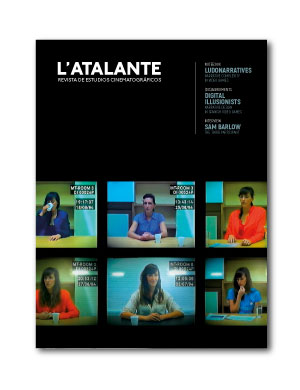On Thieves and Heartthrobs: Variations on <i>Film Noir</i> in the Barcelona Trilogy by Arturo Fernández and Julio Coll (1956-1959)
Published 2021-01-31
Keywords
- Julio Coll,
- Arturo Fernández,
- Film noir,
- Crime drama,
- Censorship
- Francoism. ...More
How to Cite
Abstract
Due to the recent death of Arturo Fernández, this work seeks to study the figure of filmmaker Julio Coll, through their collaboration in three pivotal films of the Spanish cinema of the 50s: Nunca es demasiado tarde (1956), Distrito quinto (1957) and Un vaso de whisky (1959). This «noir trilogy» sets two parallel lines of analysis: the first one traces the representation of social issues in Spain; the second one focuses on the dramatic evolution of Fernández’s early roles. The aim is to identify the thematic, narrative and formal key points of an almost forgotten artist and remember that the beginnings of the famous actor went hand in hand with a very particular genre of our national cinematography. Thus, we will define the collian poetic and its correlation with both Franco censorship and morality and the codes of film noir.
Downloads
References
Castro de Paz, J. L. (1997). Distrito quinto. En J. Pérez Perucha (ed.), <em>Antología crítica del cine español</em>: <em>1906-1995</em> (pp. 420-422). Madrid: Cátedra. <br>
Comas Puente, Á. (2018). Julio Coll Claramunt. <em>Real Academia de la Historia</em>. Recuperado de http://dbe.rah.es/biografias/4631/julio-coll-claramunt<br>
Heredero, C. F. (1993). <em>Las huellas del tiempo</em>. València: Filmoteca de la Generalitat Valenciana.<br>
Heredero, C. F., Santamarina, A. (1998). <em>El cine negro</em>. Barcelona: Paidós.<br>
Martín, J. M. (2018). Señales de marca. Noir ibérico. Recuperado de https://cutt.ly/9eJKfyz<br>
Medina, E. (2000). <em>Cine negro y policiaco español de los años cincuenta</em>. Barcelona: Laertes.<br>
Medina, E. (2017). El cine negro y policial español: los años cincuenta y la especialización barcelonesa. <em>Trípodos, 41</em>, 15-33. Recuperado de http://www.tripodos.com/index.php/Facultat_Comunicacio_Blanquerna/article/view/432 <br>
Monterde, J. E. (1995). Continuismo y disidencia (1951-1962). En VV. AA., <em>Historia del cine español</em> (pp. 239-295). Madrid: Cátedra.<br>
Sánchez, E., Ocaña, J. (2016). <em>Presentación de </em>Distrito quinto<em> en </em>Historia de nuestro cine. Recuperado de https://www.rtve.es/alacarta/videos/historia-de-nuestro-cine/historia-nuestro-cine-258/3828371/ <br>
Sánchez Barba, F. (2001). <em>Una proyección cultural del franquismo: el auge del cine negro español (1950-1965)</em>. Tesis doctoral. Barcelona: Universidad de Barcelona. Recuperado de http://diposit.ub.edu/dspace/bitstream/2445/<br>
116683/1/02.FSB_2de9.pdf <br>
Talens, J. et al. (2015). Deshaciendo tópicos. Una discusión a cinco voces sobre el cine español de la posguerra<em>. L’Atalante. Revista de estudios cinematográficos, 20</em>, 76-90. Recuperado de http://www.revistaatalante.com/index.php?journal=atalante&page=article&op=view&path%5B%5D=313 <br>
Zunzunegui, S. (2018). <em>Historias de España. De qué hablamos cuando hablamos de cine español</em>. Santander: Shangrila.</p>

